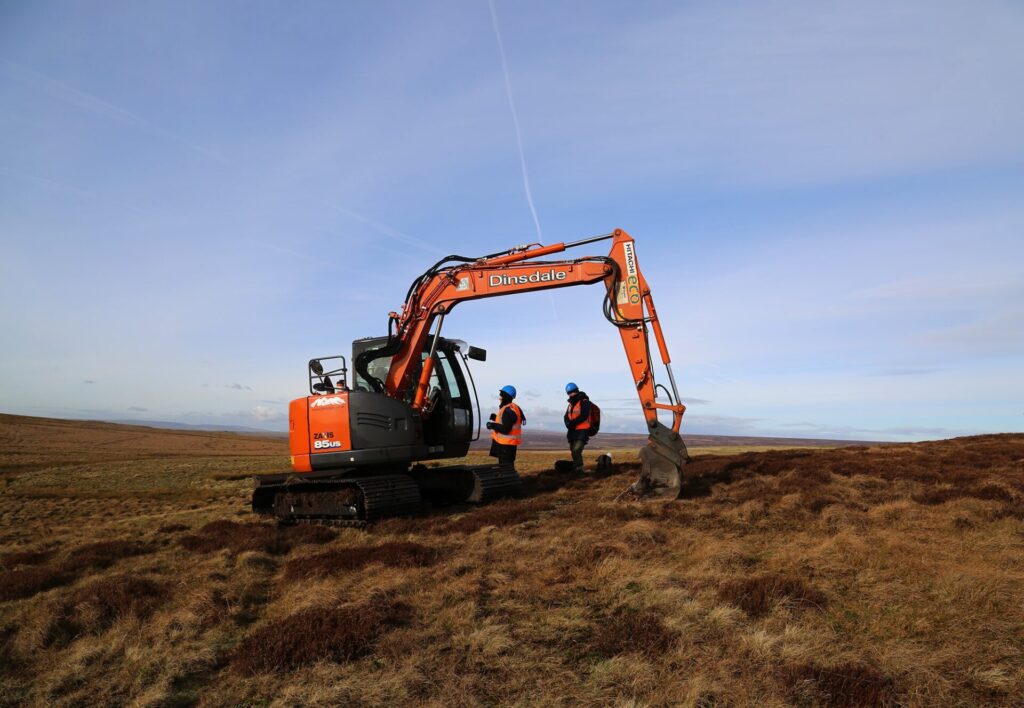
Pictured: – Visit to Fleet Moss, photo by Laura Harrington
Laura Harrington and Feral Practice (Fiona MacDonald), the UK Artists in Residence for WaterLANDS, have been busy during their first year exploring the Great North Bog – the UK Action Site which is a network of peatlands in Northern England – and getting to know their communities and stakeholders.
They made their first research trip to the site last June and realised how challenging their work was going to be because it consists of so many peatlands spread across a wide expanse of Northern England, each with different characters and challenges.
During this trip, they visited University of Leeds to meet the interdisciplinary WaterLANDSUK team, including hydrologist Dr Richard Grayson, community engagement lead Dr Josh Cohen, ecologist Professor Lee Brown and economist Professor Julia Martin-Ortega. The following day they went on a tour of Denton Moor in Ilkley with Lucy Lee, Wilder Communities engagement officer with Yorkshire Wildlife Trust. They spent some time together exploring and talking, visiting relevant exhibitions in Sheffield and some very degraded peatlands around the Peak District.
During their first meeting the artists were struck by the speed at which the financial markets around peatland restoration was moving, in contrast to the slowness of peatland processes themselves.
‘Tenderbog’ is born
In September, they visited Fleet Moss peatlands in Yorkshire for a group site visit, led by Jenny Sharman, Training and Stakeholder Engagement Officer, at Yorkshire Peat Partnership, looking at the different strategies for the experimental restoration that has been going on there since 2009 and attended a large group meeting with the communications teams from across the site.
During this visit the artists named their research collaboration ‘Tenderbog’ to reflect their intended focus on touch and tenderness and their desire to convey the work of peat restoration as a place for intimacy, care and empathy.
Feral Practice explained: “We are especially inspired by ideas around healing and tenderness in relation to the restoration processes we saw. We noticed that the materials and objects involved in preventing erosion have formal similarities to objects and materials used in wound care. We wonder also if the actions (though very different in scale and technology) might mirror actions made in the tending of human wounds.”
Jenny said: ‘It’s been wonderful to work with Laura, Fiona and Josh, and to see our peaty world through their eyes. I’ve learnt a great deal and love how the ‘Tenderbog’ concept intertwines and connects humans with the land. It’s only through tenderness and care that we will be able to restore these damaged landscapes.’
Returning to Fleet Moss
This month, (February) the artists returned to Yorkshire for a visit focusing on observing and engaging with the contractors and the people who do the physical work of peatland restoration. In Nidderdale, they watched the great care taken by the contractors, using a huge digger to make “incredibly delicate movements” to cover places where erosion had exposed bare peat with heather and vegetation. Chris, one of the digger drivers, shared how proud he was working to restore peatland over the last 12 years. They noted the contrasts and echoes between the micro and macro – what happens at the global scale, and how this mirrors the micro detail of healing taking place between the bacteria, fungi, plants and animals in a single bog pool.
“Our work is exploratory and collaborative. It felt important to observe and engage with the contractors. These are after all people working in all weathers, often for hours, days and months on site, moving and shaping the landscape. Chris described how moving peat with his digger was sometimes like spreading butter. That analogy revealed the scale of their movements and the kind of understanding they have of peatlands. Our work is very much about listening to others, human and non-human, and paying attention to the tiniest of things. This, we hope, opens space for different kinds of questions to occur, such as Jenny asking Chris, the digger driver whether he believes peatland restoration has changed him as a person,’ said Laura Harrington.
Plans for the future include online events to bring people from diverse backgrounds together to contribute to the research and creating a virtual bog.
A group trip to Greifswald in Germany is being planned for June 2024 where the artists from the six countries can spend time together and learn about each others’ work and visit some wetlands as well.
Keep in touch
You can read updates from each of the artists-in-residence on the WaterLANDS website and follow their progress on Instagram by following WaterLANDS Art. For news about the work of the WaterLANDSUK team, sign up to our newsletter

Pictured: Working with peat at Nidderdale, photo by Laura Harrington
